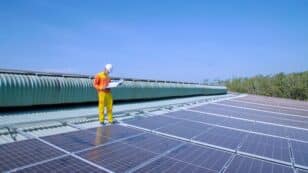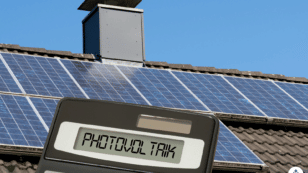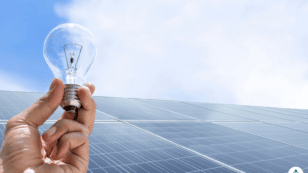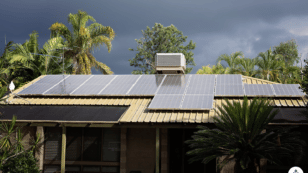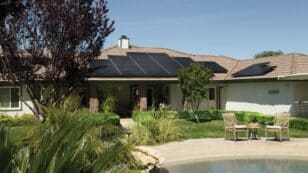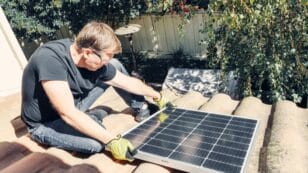
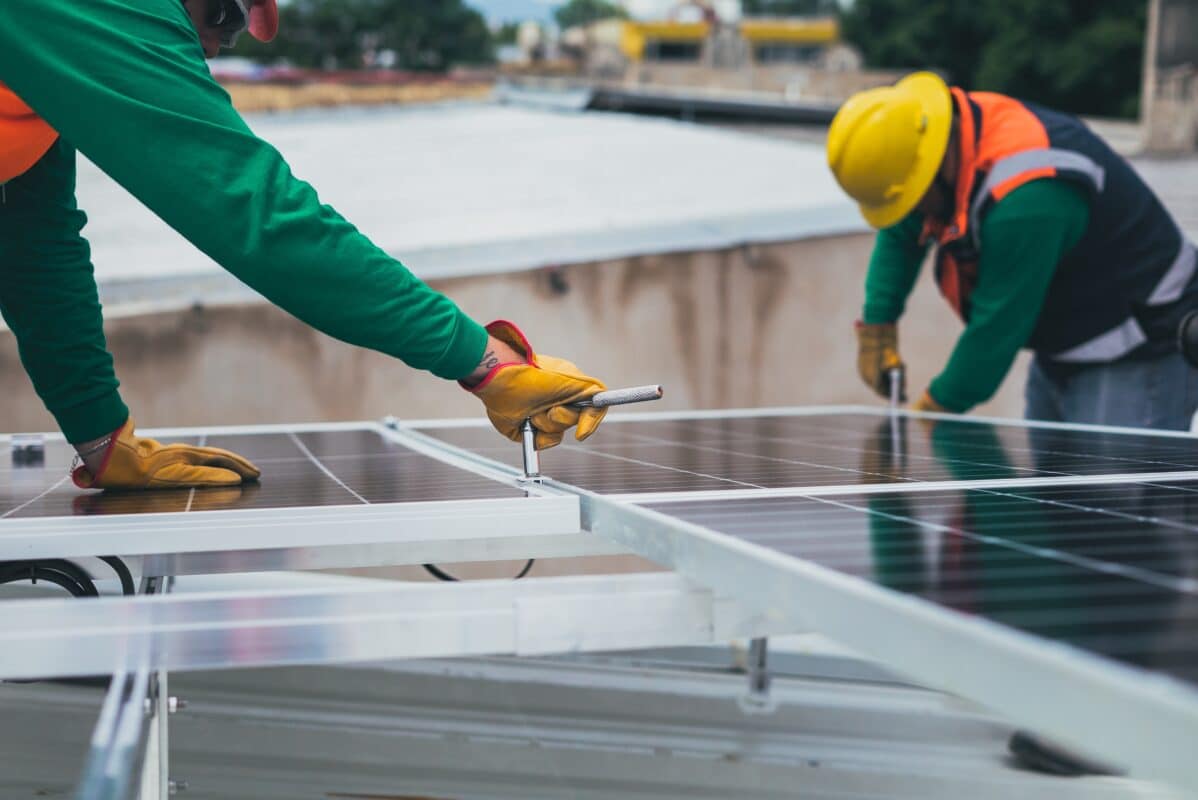
How to Install Solar Panels Guide (2024 Solar Panel Installations)
Here’s what we’ll cover in this guide:
- How to secure solar install permits
- Selecting the right equipment
- Vetting qualified solar contractors
- Installing your solar system
Each product and or company featured here has been independently selected by the writer. You can learn more about our review methodology here. If you make a purchase using the links included, we may earn commission.
5 Steps for Solar Panel Installation
By installing a home solar power system, you can reduce your dependence on traditional utility companies, offsetting the majority (or entirety) of your monthly energy bills. Plus, it offers a tangible method to curb your environmental footprint, making for cleaner, healthier communities.
Somewhat counterintuitively, the majority of what determines a successful solar project has little to do with the installation itself. Before getting into how to install solar panels, there are a couple of nuances to note off the bat. First, installing solar panels requires thorough knowledge of solar technology, design and engineering. And it also demands an intimate knowledge of electrical systems and wiring.
In other words, the average person will likely want to avoid a DIY solar panel installation and leave the process to professional local installers. A properly designed and installed PV system will provide far more savings on the backend than most DIY installations will save on the front. The second thing to consider is that solar panel installation won’t happen overnight.
Even after you choose the best solar panels for the job, there are a few vital steps in the installation process essential for ensuring a reliable, effective and efficient renewable energy system. Here are the basic steps of solar panel installation:

SunPower

Nationwide Service
Average cost
Pros
- Most efficient panels on the market
- National coverage
- Cradle to Cradle sustainability certification
- Great warranty coverage
Cons
- Expensive
- Customer service varies by local dealer
SunPower designs and installs industry-leading residential solar and storage solutions across all 50 states. With a storied history of innovation dating back to 1985, no other company on this list can match SunPower’s experience and expertise.
SunPower earns its position as the top national installer on our list for a handful of reasons: It installs the most efficient solar technology on the residential market, offers the most expansive service area and backs its installations with a warranty well above the industry standard. All the while, SunPower pioneers sustainability efforts within the industry.
If that weren’t enough, SunPower systems come packaged with products all manufactured in-house by its sister company, Maxeon. This means that your panels, solar cells, inverters, battery and EV chargers are designed to work together and are all covered under the same warranty.
SunPower’s biggest downside? Its high-efficiency panels are considerably more expensive than most of its competitors’ products. However, its powerful panels are workhorses that make up for the initial cost with more backend production (think about this like spending more money for a car that gets more miles per gallon).
Facts and Figures: SunPower
| EcoWatch Rating |
|---|
| Better Business Bureau (BBB) Rating |
| Year Founded |
| Average Cost ($-$$$$$) |
| Solar Services |
| Brands of Solar Equipment Offered |
| Warranty Coverage |
| 5 |
| A+ |
| 1985 |
| $$$$ |
| Solar Panels, Solar Batteries, EV Chargers, System Monitoring |
| SunPower Panels |
| 25-year all-inclusive warranty |

Blue Raven Solar

Regional Service
Average cost
Pros
- Industry-leading in-house financing
- Competitive pricing
- Excellent reputation
Cons
- Doesn't offer solar batteries (coming 2022)
We like Blue Raven Solar because it understands that, for most homeowners, the cost of solar presents the biggest barrier to entry.
For that reason, Blue Raven Solar developed an innovative solar financing plan that offers in-house, flexible, zero-money-down options. The results speak for themselves, as Blue Raven Solar is now one of the fastest-growing solar companies in the nation and was recently acquired by SunPower. Its BluePower Plus+ plan (exclusive to Blue Raven) mimics the flexible structure of a lease while still providing the greatest benefits of owning your system.
Eligible homeowners enjoy 18 months of solar power before having to pay their first bill. When coupled with the federal solar investment tax credit (ITC), the initial energy savings can offset more than a third of the overall cost of a system before requiring a dollar down.
In contrast, other installers can only offer similar financing through solar leases, PPAs or third-party providers (such as Mosaic or Sunlight). Third-party loan providers can complicate the process, while opting for a loan or PPA will disqualify you from some of solar’s biggest benefits (additional property value, federal solar tax credit and local solar incentives).
Facts and Figures: Blue Raven Solar
| EcoWatch Rating |
|---|
| Better Business Bureau (BBB) Rating |
| Year Founded |
| Average Cost ($-$$$$$) |
| Solar Services |
| Brands of Solar Equipment Offered |
| Warranty Coverage |
| 4.5 |
| A+ |
| 2014 |
| $$ |
| Solar Panels, System Monitoring |
| Trina Solar, Canadian Solar, SolarEdge, Silfab, SunPower |
| 25-year manufacturer warranty; 10-year workmanship warranty, 2-year production guarantee |
1) Complete a Site Survey With an Engineer
Once you choose the best solar installation company for your home and sign a contract, the company will send an engineer to your home to evaluate your current electrical system, ensuring everything is compatible with your intended solar panel system design. They should also inspect your roof for condition — as you might need replacement before installing solar to avoid costly removal down the road — and make sure that your home can structurally support the added weight of the panels.
This engineer may be an employee of the solar company or an independent contractor. Be aware that if you have an old and outdated electrical system, the engineer may tell you that it needs to be upgraded or replaced. This is generally an indication that your new solar energy system will produce more amps than what your current electrical system can accommodate. Upgrading your electrical service should also add value to your home, so it’s worthwhile.
In addition to checking out your electrical system, the engineer will also want to inspect your roof. They’ll need to ensure it is structurally sound and able to support the weight of solar paneling. Also, the engineer will be able to tell you if you need a specialized mounting system, such as for a flat roof. As mentioned above, they’ll confirm that your roof has the 20 to 25 years of life left in it that your panels are expected to last.
A solar energy system will only perform as well as it’s designed, so hiring a trustworthy solar engineer is one of the most important steps in the process. Still looking for an installation company? Click here to get connected with a solar installer in your area and receive a free quote.
2) Secure the Right Permits
Before your solar panel installation, you’ll have a few bureaucratic hoops to jump through. Specifically, you’ll need to obtain all the right permits and documentation to ensure your solar panel installation is legal, meeting all local safety and zoning requirements.
You wouldn’t believe the headaches that can accompany an installation carried out before permits are issued. Just as en example, if your building department finds out that you’ve installed solar without the proper permits, they will very likely require that you remove the panels and start over with the right permission. While you might save some money DIYing your panels or avoiding permits, you’ll almost certainly end up paying more in the long run if you make this mistake.
This step may sound intimidating, but here’s the good news: While there is plenty of paperwork associated with installing solar panels, the majority of it is handled by your solar company.
You may not have to do much at all beyond lending a signature here and there, but it’s still important to have some sense of what’s happening behind the scenes. Here’s what your solar installer will file for:
- Local electrical and/or building permits on your behalf
- Interconnection agreement with your local utility (in other words, permission from your utility to install solar and enroll in net metering programs)
- Applications for state or federal incentive programs that help curb the upfront cost of solar panels — potentially bringing the national average cost down from $29,970 to $20,979 with just the federal tax credit alone, not including state and local incentives they might find for you
By completing this paperwork, you can potentially secure rebates, tax credits or other financial assistance to offset installation costs. It will take your solar installer some time to submit all the paperwork, and even longer for governmental bodies to process all the information — sometimes several weeks or more.
It’s not a bad idea to follow up and get updates every week or so, especially if you hire a less communicative company, just to make sure the process is still moving forward smoothly. Solar companies are busy with business, but the squeaky wheel gets the grease.
If you’re ready to start getting quotes from local installers near you, use the links below.
3) Order the Right Equipment
Once you have all the correct permits and paperwork in place, your solar installer will be ready to order your equipment. Note that, by this point, your installer will already have picked out the types of solar panels you need and the best solar batteries and inverters for your home.
This is another benefit of going with a professional installer — they have access to the panel brands with the highest efficiencies and longest warranties. Just for comparison, the peak efficiency for professionally-installed panels is 22.8% from Maxeon, while DIY panels peak at around 20%. In terms of warranty coverage, those professionally-installed brands usually come with between 20 and 25 years of protection for the equipment, production, as well as 10 to 20 years for the labor. DIY panels often have 5 to 10 years of coverage for the equipment and production and no labor warranty.
The equipment decisions are typically laid out in a solar proposal, sent well before you sign your contract. Naturally, you’ll want to make sure you research how solar panels work and the different options available to you.
Whether you want the most efficient solar panels or the most affordable, your solar installer can help you pick equipment that will help you achieve your solar energy goals. Once your solar equipment is ordered, your name will be added to the installer’s queue. Basically, this means you’ll be put on the schedule for an installer to assemble your solar panels as soon as they arrive from the distributor.
4) Get Your Solar Panels Installed
Finally, the big day arrives. Your solar installer will show up and begin preparing your roof, specifically by verifying that all tiles or shingles are securely attached and holes for the mounting rack are placed properly. Then, the installer will place the wiring that’s needed to connect your residential solar system to the electrical system.
After the wires are placed, your installer will place racking, which is used to hold the solar panels in position. The panels are placed into the racks, and the inverter (or several microinverters) are usually connected to the panels.
If you have a battery bank, your installer will also set that up. To learn more about a top solar battery, read this article on the Generac PWRcell home battery.
One of the most common questions about installing solar panels is how long the work will take. It all depends on the size of your home and the scope of the solar panel installation, but you can anticipate a timeline of one to three days in total. If your solar system is properly designed and planned out, this step of the process should actually be the most straightforward. You just need to make sure you’re home on the installation day.
5) Get your system approved and connected.
Once the system is in place, your installer will essentially “flip the switch” to turn it on. Before this happens, you’ll likely need a municipal government representative or someone from your electric company to assess and approve your residential solar system, issuing what’s called permission to operate (PTO).
Basically, this is just a safety precaution, ensuring there’s a fresh set of eyes to validate the wiring and electrical work — another step that could cause a real headache if you try to install your panels yourself. You’ll also need a representative from your local utility company to interconnect the system, which means hooking it up to the electrical grid.
This allows you to keep drawing electricity when you need it, as well as safely feed any surplus energy back into the grid, which can result in credits from your utility company via net metering programs.
Questions About How to Install Solar Panels?
These five steps represent the basics of how to install solar panels. But of course, these are just general guidelines, and specific steps can vary from home to home and from installer to installer. If you have additional questions about how to install solar panels, a good next step would be to seek out the top solar companies in your area and make an appointment for a consultation.
You can ask more about specific solar panel installation processes and what you might expect if you decide to make the leap into solar power.
You can use the links below to get a free quote and book a consultation with a certified solar energy installer in your area.
FAQ: How to Install Solar Panels
Technically speaking, yes, you can install solar panels on your own home. However, we don’t recommend this unless you have experience as an electrician and advanced knowledge of solar energy.
Though we don’t doubt your ability to pull off a satisfying DIY home project, the modern technology solar companies use to design and plan solar installations can provide far more long-term benefits than the savings you might secure from installing solar panels yourself.
The number of solar panels needed to power a house will vary depending on the amount of electricity your home consumes. As a minimum, however, we’d expect most homes will require at least 20 to 25 panels. With the average panel size of 400 watts, that puts your total system size between 8,000 watts (8 kW) and 10,000 watts (10 kW). The typical system size required in the U.S. is 9 kW.
Solar panels are installed roughly in the following order. Note that unless you have electrical contracting experience, we recommend homeowners hire professionals to carry this out.
Step 1: Install your racking or build a platform for the solar panels
Step 2: Mount and secure the solar panels on the racking
Step 3: Wire the solar panels
Step 4: Connect the wiring to your control panel
Step 5: Ground your system for safety purposes Step 6: Connect your solar array to your home
Comparing authorized solar partners
-
- Most efficient panels on the market
- National coverage
- Cradle to Cradle sustainability certification
- Great warranty coverage
- Expensive
- Customer service varies by local dealer
A+Best National Provider1985SunPower Panels25-year all-inclusive warranty
Having trouble deciding? Click below and use our process to receive multiple quotes instead:

 233k
233k  41k
41k  Subscribe
Subscribe 



